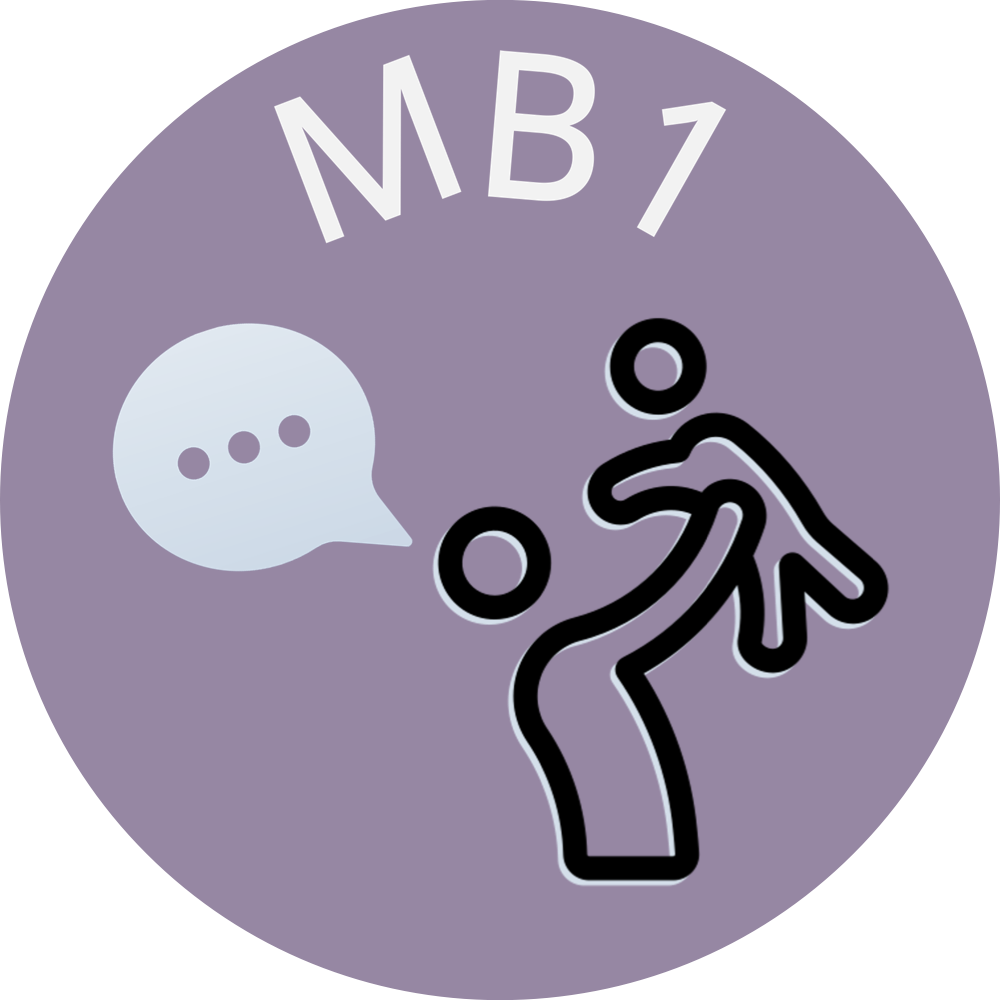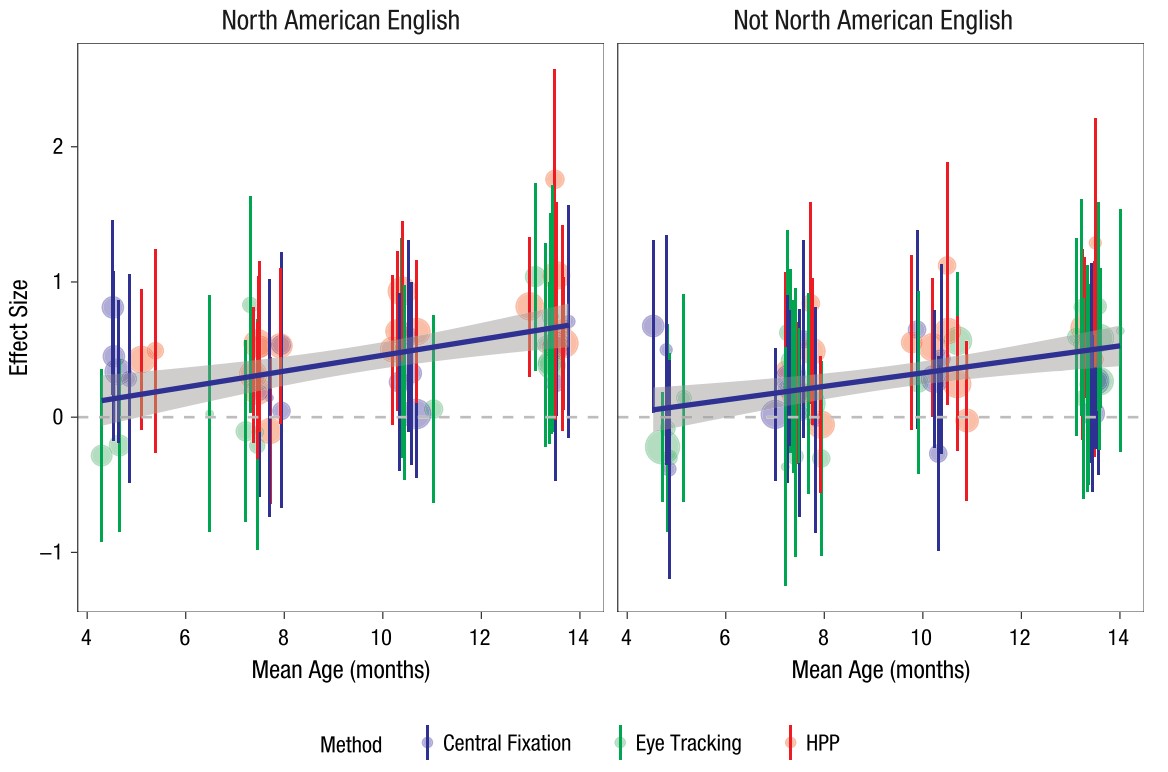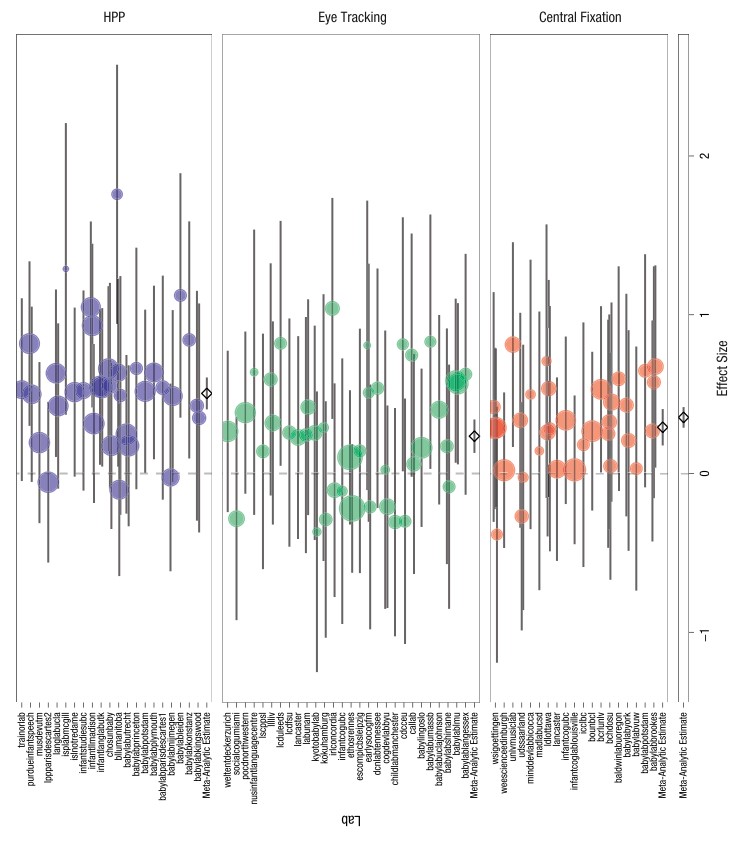
Project Overview
- Status: COMPLETE
- 69 participating labs collected data in 16 countries
- 2,329 babies tested
- 149 authors on AMPPS publication
In the first ManyBabies project, we replicated a robust finding from developmental literature: infants’ preference for infant-directed speech (IDS) over adult-directed speech (ADS). IDS is characterized by a higher pitch, greater pitch excursions, and shorter utterances when compared to ADS. Exposure to IDS has been shown to improve word segmentation and word learning. We asked if infants have a preference for IDS, and how this preference varies across age, native language background, and method.
 Sixty-nine labs from 16 countries participated and collected data from 2,329 infants (range: 3-15 months old). We focused on three primary methods for assessing infants’ interest: single-screen central fixation, eye tracking, and the head-turn preference procedure (HPP).
Sixty-nine labs from 16 countries participated and collected data from 2,329 infants (range: 3-15 months old). We focused on three primary methods for assessing infants’ interest: single-screen central fixation, eye tracking, and the head-turn preference procedure (HPP).
Results
- Confirmed that infants prefer to listen to infant-directed speech relative to adult-directed speech
- Stronger effect in older children, in those children for whom the stimuli matched their native language and dialect (North American English, or NAE), and in data from labs using the head-turn preference procedure (magnitude of 0.05 SDs per month), suggesting a modulation by experience, maturation, or both
- IDS preference even among participants whose native language or dialect was not NAE
- Effect strongest with the HPP relative to central-fixation or eye-tracking approaches; one potential interpretation of this finding is that the greater effort on the part of the infant in the HPP (i.e., turning the head, as opposed to making small eye movements) leads to stronger engagement in the task and therefore to stronger effects


Links
- Materials, Protocols, and Documentation: MB1-OSF
- Walkthrough videos: Databrary
- Data and code: MB1-GitHub
- Listserv: join here
- News: MB1-news
Project Leads
- Michael Frank, Stanford University, United States [email]
- Melanie Soderstrom, University of Manitoba, Canada [email]
MB1 Contributors
NOTE: Default table ordering is by contributor’s first name. You can filter, group, and/or sort entries by any field.
Publications
ManyBabies Consortium. (2020). Quantifying sources of variability in infancy research using the infant-directed-speech preference. Advances in Methods and Practices in Psychological Science, 3(1), 24–52. https://doi.org/10.1177/2515245919900809 [PsyArXiv preprint]
Byers-Heinlein, K., Bergmann, C., Davies, C., Frank, M. C., Hamlin, J. K., Kline, M., Kominsky, J. F., Kosie, J. E., Lew-Williams, C., Liu, L., Mastroberardino, M., Singh, L., Waddell, C. P. G., Zettersten, M., & Soderstrom, M. (2020). Building a collaborative psychological science: Lessons learned from ManyBabies 1. Canadian Psychology/Psychologie canadienne, 61(4), 349–363. https://doi.org/10.1037/cap0000216 [PsyArXiv preprint]
Spin-off Projects & Secondary Analyses
- MB1A: Infant-Directed Speech Preference in African Infants
- MB1B: Infant-Directed Speech Preference in Bilingual Infants
- MB1G: Gaze Following in Monolingual and Bilingual Infants
- MB1L: Longitudinal Vocabulary Follow-up
- MB1N: Native Languages Follow-up
- MB1T: Test-Retest Follow-up
- MB1-Meta: Comparison to meta-analytic data
- MB1-Demo: Analysis of supplemental demographic variables